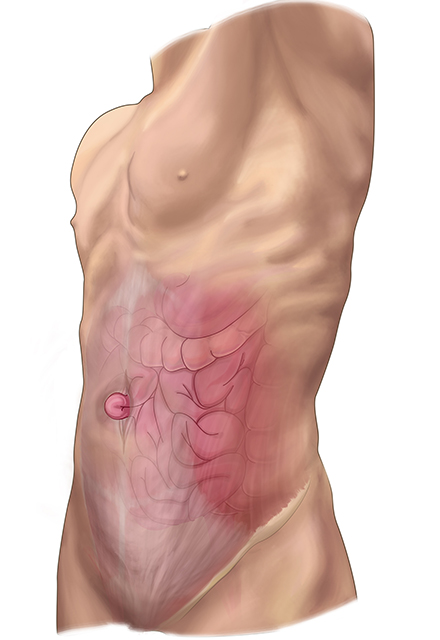Inguinal and Umbilical Hernia
What is a hernia?
A hernia occurs when a section of intestine protrudes through a weakness in the abdominal muscles. A soft bulge is seen underneath the skin where the hernia has occurred.
In children, a hernia usually occurs in 1 of 2 places:
-
Around the belly button
-
In the groin area
A hernia that occurs in the belly button area is called an umbilical hernia.
A hernia that occurs in the groin area is called an inguinal hernia.
What causes a hernia?
A hernia can develop in the first few months after the baby is born because of a weakness in the muscles of the abdomen. Inguinal and umbilical hernias happen for slightly different reasons.
What is an inguinal hernia?
An inguinal hernia occurs when part of an internal organ bulges through a weak area of muscle that forms the wall of the abdomen at the groin. This may result in a visible groin bulge or (in males) a bulge or mass within the scrotum. The bulge may hurt or burn at times.
Most inguinal hernias happen because an opening in the muscle wall does not close as it should before birth. That leaves a weak area in the belly muscle. Pressure on that area can cause tissue to push through and bulge out. A hernia can occur soon after birth or much later in life.
Inguinal Hernias in Children | Q&A with Dr. Clint Cappiello
What is an umbilical hernia?
When the fetus is growing and developing during pregnancy, there is a small opening in the abdominal muscles so that the umbilical cord can pass through, connecting the mother to the baby. After birth, the opening in the abdominal muscles closes as the baby matures. Sometimes, these muscles do not meet completely, and there is still a small opening present. A loop of intestine can move into the opening between abdominal muscles and cause a hernia.
Who is at risk for developing a hernia?
Hernias occur more often in children who have one or more of the following risk factors:
-
Prematurity
-
A parent or sibling who had a hernia as an infant
-
Abnormalities of the genitourinary system
Inguinal hernias occur:
-
In children who have a family history of inguinal hernias
-
More often in infants and children with other urogenital anomalies
-
More often in the right groin area than the left, but can occur on both sides
Umbilical hernias occur:
-
More often in African-American children
-
More often in premature infants
Why is a hernia a concern?
Occasionally, the loop of intestine that protrudes through a hernia may become stuck, and is no longer reducible. This means that the intestinal loop cannot be gently pushed back into the abdominal cavity. When this happens, that section of intestine may lose its blood supply. A good blood supply is necessary for the intestine to be healthy and function properly.
What are the symptoms of a hernia?
Hernias usually occur in newborns, but may not be noticeable for several weeks or months after birth.
Straining and crying do not cause hernias; however, the increased pressure in the abdomen can make a hernia more noticeable:
-
The main symptom of an inguinal hernia is a bulge in the groin or scrotum. It often feels like a round lump. The bulge may form over a period of weeks or months. The hernia may be painful, but some hernias cause a bulge without pain.
A hernia also may cause swelling and a feeling of heaviness, tugging or burning in the area of the hernia. These symptoms may get better when you lie down.
Sudden pain, nausea and vomiting are signs that a part of your intestine may have become trapped in the hernia. Untreated hernias can cause pain and health problems .
-
Umbilical hernias appear as a bulge or swelling in the belly-button area. The swelling may be more noticeable when the baby cries, and may get smaller or go away when the baby relaxes. If your doctor pushes gently on this bulge when the child is calm and lying down, it will usually get smaller or go back into the abdomen.
If the hernia is not reducible, then the loop of intestine may be caught in the weakened area of abdominal muscle. Symptoms that may be seen when this happens include the following:
-
A full, round abdomen
-
Abdominal pain and tenderness
-
Fussiness
-
Redness or discoloration adjacent to the hernia
-
Fever
The symptoms of a hernia may resemble other conditions or medical problems. Always consult your child's doctor for a diagnosis.
How are hernias diagnosed?
A doctor can confirm the presence of a hernia during a physical exam. The mass may increase in size when coughing, bending, lifting or straining. The hernia (bulge) may not be obvious in infants and children, except when the child is crying or coughing.
What is the treatment for hernias?
Specific treatment will be determined by your child's doctor based on the following:
-
Your child's age, overall health, and medical history
-
Type of hernia
-
Whether the hernia is reducible (can be pushed back into the abdominal cavity) or not
-
Your child's tolerance for specific medications, procedures, or therapies
-
Your opinion or preference
Inguinal hernia. The usual treatment for a hernia is surgery to repair the opening in the muscle wall. There are various surgical strategies that may be considered in the planning of inguinal hernia repair. These include the consideration of mesh use, type of open repair and use of laparoscopy, a more minimally invasive approach to abdominal surgery.
However, smaller hernias with no symptoms can sometimes be watched. Most people with hernias have surgery to repair them, even if they do not have symptoms. This is because many doctors believe surgery is less dangerous than strangulation — a serious problem that occurs when part of your intestine gets trapped inside the hernia.
Babies and young children are more likely to have tissue get trapped in a hernia. If your child has a hernia, he or she will need surgery to repair it.
Umbilical hernia. By age 1, many umbilical hernias will have closed on their own without requiring surgery. Nearly all umbilical hernias will have closed without surgery by age 5.
Placing a coin or strap over the hernia will not fix it.
There are many opinions about when a surgical repair of an umbilical hernia is necessary. In general, if the hernia becomes bigger with age, is not reducible, or is still present after age 3, your child's doctor may suggest that the hernia be repaired surgically. Always consult your child's doctor to determine what is best for your child.
During a hernia operation, your child will be placed under anesthesia. A small incision is made in the umbilicus (belly button). The loop of intestine is placed back into the abdominal cavity. The muscles are then stitched together. Sometimes a piece of mesh material is used to help strengthen the area where the muscles are repaired.
Children who have an umbilical hernia surgically repaired may also be able to go home the same day they have surgery.








